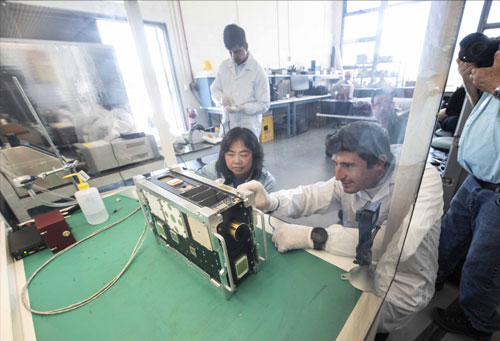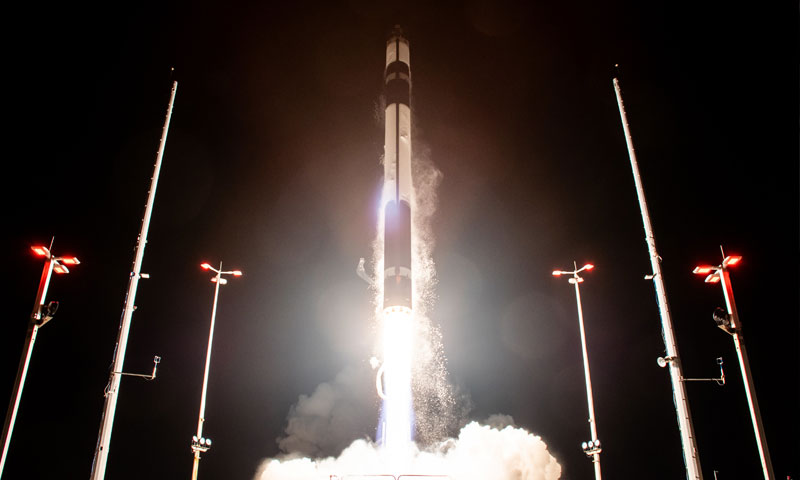In the dark, early morning sky of March 21 over NASA’s Wallops Island Flight Facility on the Virginia coast, a Rocket Lab Electron rocket carried a National Reconnaissance Office (NRO) manifest featuring three collaborative research missions into low-Earth orbit – including the latest piece of home-grown space hardware from the Naval Postgraduate School (NPS).
Led by Associate Research Professors Dr. Wenschel Lan, principal investigator, and Dr. Giovanni Minelli, co-principal investigator, from NPS’ Space Systems Academic Group (SSAG), the Mola CubeSat mission which launched into space aboard NROL-123 includes two payload experiments built by NPS – a terahertz imaging camera (TIC) and an LED on-orbit payload (LOOP) – and a radio transmitter built by New Zealand’s Defense Science and Technology unit.
NPS Department of Physics Professor Fabio Alves, along with Associate Professor Drago Grbovic and Professor Emeritus Gamani Karunasiri, have been leading the effort to advance the TIC and the technology behind it. Since 2018, an NPS campus collaboration between the Sensor Research Lab and the Small Satellite Lab has allowed faculty and students to develop a series of flight payloads to demonstrate this cutting-edge technology.
The LOOP, built by Ph.D. candidate U.S. Marine Corps Maj. Dillon Pierce, is the first step towards an optical tracking and communications capability. The long-term effort seeks to advance NPS research into free-space optical communications for CubeSats and small satellites, using highly directional optical lasers to increase speed and security of low-earth orbit (LEO) communications while avoiding congested radio frequencies. The initial experiment with LOOP is to visually observe the ultra-bright LEDs on the satellite. Plans are to eventually track LOOP with a 70-centimeter optical terminal telescope based atop the roof of NPS’ Spanagel Hall.

Dr. Wenschel Lan and Dr. Giovanni Minelli from the Space Systems Academic Group at the Naval Postgraduate School (NPS) prepare the Mola CubeSat small satellite for its March 21 launch by the National Reconnaissance Office. (Photo by Javier Chagoya)
“The NPS mission is to educate our warrior-scholars, and Mola will certainly continue to achieve that objective,” said Lan. “Over the past few years, we have integrated this research into Space Systems coursework so that students can work with real spaceflight hardware as part of their regular curriculum in addition to thesis research. We’ve also had a great experience working with our Five Eyes partners, and it has given us a chance to collaborate with our colleagues on campus as well.”
Mola’s payloads are directly supported by NPS’ Mobile CubeSat Command and Control (MC3) network, a Department of Defense-sponsored effort that began in 2011 at NPS. Over the years the SSAG has developed partnerships with nine other tracking facilities, leading to a community-based, U.S. government sponsored ground station network for small satellites, or SmallSats. These include three other DOD service universities, civilian institutions, industry partners, and governmental agencies across the country, working within a distributed operations network that share tracking responsibilities via parallel ground stations.
The MC3 project contributes to an important collaborative relationship of the Five Eyes (FVEY), an intelligence alliance between Australia, Canada, New Zealand, the United Kingdom, and the United States. These countries are parties to a treaty for joint cooperation in signals intelligence, and the MC3 network plans to eventually collaborate with the FVEY International SmallSat Command and Control Network (ISC2N).
By chance, Minelli and SSAG Faculty Associate for Research Alex Savattone were in Auckland, New Zealand for the NROL-123 launch.
“We’re in Auckland for a face-to-face meeting to support the FVEY program. Mola’s launch was fortuitous for us as one of Mola’s main objectives is to demonstrate communications with the FVEY ground stations,” said Minelli.
The first few hours after Mola was launched were intense and exciting, as the team looked to establish communications with the satellite. And it worked out very well.
“The team, led by Dr. Wenschel Lan and Dr. Gio Minelli, had acquisition of data from the CubeSat on the first pass after deployment,” said Dr. Jim Newman, SSAG chair.
It may sound simple – but it isn’t, with many procedural steps that had to be completed once the Electron rocket deploys its payloads in low earth orbit (LEO).
“When the spacecraft is ejected, it will power itself up,” explained Minelli before the launch. “It will turn on its GPS receiver to determine its position. Its star tracker will take pictures of the stars, determining the satellite’s orientation based on a preloaded star map. If the battery levels are sufficient, the satellite will then turn on its reaction wheels and attempt to stabilize itself, with its solar panels facing the sun.”
Emotions during the launch and deployment of Mola were somewhat tense, as both students’ and researchers’ years of hard work had been building up to that moment, when the satellite passed over NPS, ready to try to communicate about 90 minutes after launch.
“It’s been a long road – we originally wrote the white paper describing this concept in 2019. Eventually we got funded, navigated the pandemic, and built it,” said Minelli. “We’re a very small team and there is a lot of us put into a mission like this. Every team member and student contributed significantly, otherwise this wouldn’t work.”
Hands-on, experiential student learning has been a core priority of SSAG since its establishment in 1982. This latest launch builds on NPS’ first foray into launching satellites into space. Back in the 1990s, long-time SSAG Chair Dr. Rudy Panholzer led the design, development, build, and launch of PANSAT, or Petite Amateur Navy Satellite. The program supported more than 50 master’s degrees and educated many others.
PANSAT was deployed from the Space Shuttle Discovery on STS-95 in 1998, the same flight that included former Project Mercury astronaut and U.S. Senator John Glenn, and it performed beyond all expectations. With a battery life and on-board systems estimated to operate for about 36 months, PANSAT remained in communications with NPS ground stations for almost eight years!
The SSAG team has launched payloads on the Space Shuttle, several CubeSats, small satellites, and innovative CubeSat deployment technologies. And Mola and future projects are now poised to continue building on this important flight history.
According to Lan, this history has in the past and will in the future support naval-relevant learning – developing affordable space assets that are not only learning opportunities for students, but will also demonstrate scalable technologies for naval and defense operations in space.
“One of our goals for the SSAG is to have satellites that the students can operate for learning spacecraft operations,” Lan said. “We’ve had so many students contribute to Mola already, and the next few cohorts will continue to reap the benefits.”
Naval capabilities in the maritime domain depend increasingly upon effective knowledge and skills, such as those taught at NPS, to deploy and operate systems in the space domain.
“NPS provides the kind of hands-on learning experience with direct mission application that our Secretary of the Navy, Carlos Del Toro, benefited from himself when he was an NPS Space Systems student, and we intend to continue to offer our students such opportunities in the future,” said Newman.
A pillar of research at NPS is the direct contributions of students in advancing the work. More than 20 NPS students will have directly contributed to the Mola CubeSat, as well as to the development of the next CubeSat in the FVEY series, Otter.
Lt. Chuck Bibbs, USN
Lt. Christopher Brave, USN
Lt. Col. Marcello Correa de Souza, Brazilian Air Force
Lt. Col. Robert DeBeneadto, USMC
Lt. Harrison English, USN
Lt. Col. Eric Gobrecht, USAF
Maj. Jason Kozak, USMC
Lt. Sarah Kline, USN
Lt. Cmdr. Joe Miller, USN
Lt. Anastasia Novosyolovoblatt, USN
Maj. Dillon Pierce, USMC
Capt. Mike Spain, USMC
Lt. Cmdr. Greg Bischoff, USN
Lt. Cmdr. Evan Bower, USN
Lt. Allyson Claybaugh, USN
Lt. Cmdr. Hans Lauzen, USN
Lt. Cmdr. Travis Lewis, USN
Capt. Dan Lim, USMC
Lt. Cmdr. Bianca Lovdahl, USN
Capt. Mike Spain, USMC
Maj. Matthew Stank, USAF
Lt. Cmdr. Logan West, USN


